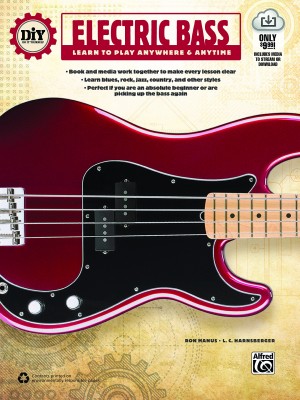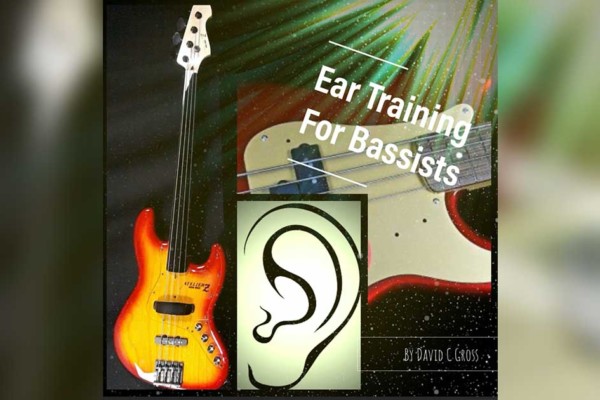“DiY Electric Bass” Teaches Bass In A Simple Way
 Do you know someone who would really love to play bass, but wants to learn in their own time and in their own way? Then DiY (Do It Yourself) Electric Bass: Learn to Play Anywhere and Anytime could be the book he or she needs.
Do you know someone who would really love to play bass, but wants to learn in their own time and in their own way? Then DiY (Do It Yourself) Electric Bass: Learn to Play Anywhere and Anytime could be the book he or she needs.
The book by Ron Manus and L. C. Harnsberger, is structured so that anyone — even those without previous musical experience — can play. The book, which approaches the topic simply and clearly, also features video lessons and accompaniments that can be streamed or downloaded.
Check out all the areas the 48-page paperback book, available here, covers for the novice:
- Accented Notes
- Ties & Syncopation
- Syncopation in the Keys of C, G, F, & B-flat
- The Dotted Quarter Note
- Rock Licks with Syncopation
- High C-sharp (or D-flat) & D
- The Key of D Major
- The D Major Scale
- Pitch Pipes and Electronic Tuners
- The Basics of Reading Music
- The Staff
- The Bass Clef
- High D-sharp (or E-flat) & E
- Placing a Finger on a String
- Tuning Your Bass
- Using the Online Media
- Tuning to a Piano or Keyboard
- Tuning the Bass to Itself
- Time Signatures
- Measures (Bars)
- Reading TAB
- Counting Time
- Four Kinds of Notes
- The Slide
- Licks in the Keys of F & B-flat
- Notes on the 1st String G
- Notes on the 2nd String D
- Combining Notes on the G & D Strings
- Notes on the 3rd String A
- Notes on the 4th String E
- The 3rd Position
- The Key of C Major
- The C Major Scale
- The Key of G Major
- The 2nd Position
- The G Major Scale
- The Two-Octave E Major Scale
- Licks in the Key of E
- Bass Fingerboard Chart
- The Key of B-flat Major
- The B-flat Major Scale
- Eighth Notes
- Rests
- The A Natural Minor Scale
- Sharps & Naturals
- Notes on the 4th Fret
- The Right Hand
- Up-Stems & Down-Stems
- Proper Hand Position
- Good King Wenceslas
- The F Major Scale
- Key Signatures
- Note Finding Review
- Flats
- The Key of F Major
- Incomplete Measures
- Licks in the Key of A
- The Key of E Major
- The E Major Scale
- The Parts of the Bass
- How to Hold Your Bass
- Proper Hand Position
- Using Your Fingers
- Using a Pick
- The Left Hand
- Combining Dotted Quarter Notes, Accents, & Slides
- Joy to the World
- Rock Licks in the Keys of G, C, & D
- Sixteenth & Dotted Eighth-Note Rhythms
- Shuffle Rhythm Bass Lines
- The Key of A Major
- The A Major Scale




Is that actually the order it covers those things? Why would you need to learn accented notes 60 steps before learning how to hold your bass? Worrying.
hmmm I dont know about this. I mean its a bunch of stuff that may be hard for a newbie to put together. I mean there are so many video courses online that are better.
Yep @Rob very good sites like Scottsbasslessons.com or talkingbass.net.
I’m learning a ton with those two alone!!!
Like Raphael I’m learning more from Mark J Smith and Scott Devine than ever before.
I can play ghost notes just fine playing finger style but slap style I cant seem to get those ghost notes in on time. But its been much fun learning from Mark and Scott.
Not that these books wont help but learning from a person online has helped me a great deal.
When I was 17 in 1974 if someone would have told me when your 59 you will have a small TV screen you will be able to learn how to play bass called You Tube I would have thought they where crazy.